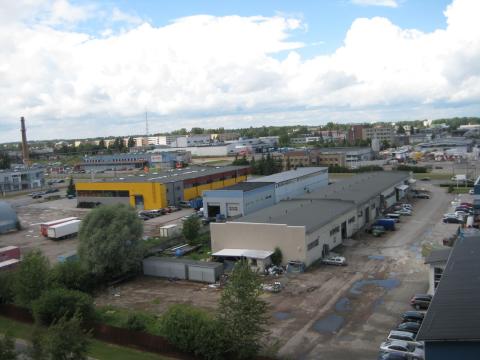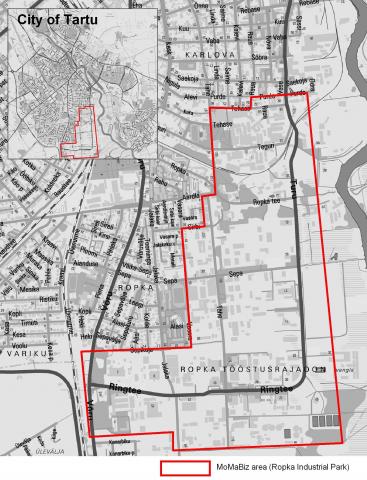The Ropka industrial zone is situated on the south part of Tartu, the second largest city of Estonia (pop 103,284). The centre of the BIZ is approximately 5 kilometres from the town centre and Annelinna, the district where approximately 30% of Tartu’s inhabitants live.
The general plan for the BIZ was made in the 80’s. The city of Tartu has a comprehensive urban plan which also includes the Ropka BIZ, which is expanding. Detailed plans are required for every new development in the BIZ, which have to be approved by the city government.
Ropka hosts different types of companies including commercial, services, productive and warehousing activities. Most of the companies are small or medium size enterprises with less than 100 employees and the majority of them has around 10-30 employees.
The majority of the employees working at the BIZ live in Tartu, however, employees also commute from other municipalities too.
The Ropka Industrial Park does not have a specific management organization or association. Plots and building owners develop and manage their property and the Municipality of Tartu determines the regulations and plans for the BIZ, however, there isn’t a body directly responsible for its management.
Discover more about Tartu and Moma.BIZ
Facts Regarding the BIZ | |
Surface | 2.687km2 |
Nr of companies | 478 |
Nr of employees | 3300 |
 The Ropka BIZ can be accessed by all modes of transport. The existing road network ensures comfortable access to the BIZ by car from every district of Tartu and there is enough parking space, free of charge, for employees, customers and visitors.
The Ropka BIZ can be accessed by all modes of transport. The existing road network ensures comfortable access to the BIZ by car from every district of Tartu and there is enough parking space, free of charge, for employees, customers and visitors.
The BIZ is also accessible by bus. The bus network covers most of the streets and the bus stops are within walking distance from most of the companies in the BIZ. The bus network ensures a direct connection with the city centre and most of the other districts in Tartu. Nonetheless, as the mobility survey has shown, the majority of the employees travel to work by car and only 20% uses public transport.
Modal Split Before the Project Implementation |
Public transport (bus): 20% Private car (driver): 60% Private car (passenger): 6% Motorbike: 1% Bike: 2% Foot: 8% Combined (car + train or bus): 3% |
The Mobility Plan
Following the information from the background study, the mobility survey and the meetings with the LMG the Mobility Plan of the Ropka BIZ focused on three main aspects:
- Public transport: improvement of the timetables and comfort, dissemination of information on routes and timetables, closer assessment of flexible transport as a viable public transport model for the BIZ.
- Light traffic, i.e. cycling and walking: accessibility and safety audit for cyclists and pedestrians, safer infrastructures for cyclists and pedestrians, installation of bicycle stands.
- Awareness raising campaigns and activities for the promotion of sustainable modes of transport: collaboration with NGOs, local and state authorities, preparation and dissemination of an accessibility map for sustainable modes of transport, organisation of a competition among the employees of the BIZ.
The Mobility Plan also identified measures for future implementation following the end of the project:
- Construction of bicycle and pedestrian road connecting the Ropka BIZ and the districts Annelinn and Ihaste.
- Improvements to the quality of the local environment (installation of benches, greenery, better lighting ect.) based on the results of walking and cycling audits.
- Separation for bicycle and pedestrian traffic from road traffic at Tähe street.
- Operation of a flexible transport line serving the BIZ of Ropka.
- Provision of real time public transport information.
- Installation a bus shelter to Vangla bus stop.
- Campaign with the theme „1 car trip less“.
- Bicycle day for local employees and their families.
- Preparation and dissemination of travel information packages for new BIZ employees.
The Impact
One of the most important achievements of the project in Tartu has been the creation of a sustainable mobility culture among the local stakeholders, i.e. local authorities, companies, local planners, engineers, transport specialists, architects, etc., which guarantees long term impact. Already the local government is taking into consideration the mobility issues of the Ropka BIZ and is basing the road improvements that will take place in 2014 on the results of the accessibility and safety audit for cyclists and pedestrians that was carried out within the framework of the Mobility Plan.
Other mobility measures implemented so far have resulted in a considerable improvement in the quality and timetables of the public transport serving the BIZ as well as in the accessibility for cycling and walking. This in association with the awareness raising activities carried out are expected to create a modal shift from car use to more sustainable modes of transport among the employees.
This modal shift will be even greater following the implementation of all the measures foreseen by the Mobility Plan and which the Municipality of Tartu will carry on implementing even after the end of the project. The additional measures will further facilitate and promote cycling and walking to and from the Ropka BIZ and make public transport more attractive to the employees.
